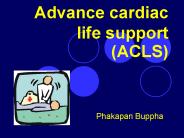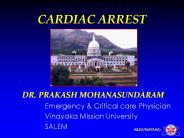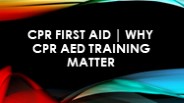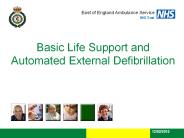Shockable PowerPoint PPT Presentations
All Time
Recommended
Title: 1 Author: Last modified by: Created Date: 8/29/2006 3:42:46 PM Document presentation format:
| PowerPoint PPT presentation | free to view
Non-shockable. Asystole. Absent ventricular (QRS) activity. Atrial activity (P waves) may persist. Rarely a straight line trace ...
| PowerPoint PPT presentation | free to view
THE AED Manual Automated Monophasic Biphasic Shockable Rhythms V-fib V-tach (pulseless) CPR and the AED Interrupt CPR as little as possible and for as short a period ...
| PowerPoint PPT presentation | free to view
Clinical Background on CPR Circulation is Critical for Survival Provides oxygen to preserve vital organ function Converts non-shockable rhythms (asystole, PEA) to ...
| PowerPoint PPT presentation | free to download
American Airlines follows Qantas's lead. FDA-designated indications for AED ... American Airlines had more shockable rhythms than Qantas, possibly because of ...
| PowerPoint PPT presentation | free to view
We also have a special circumstances in our children’s, so congenital heart disease is common, and so we will see that complex interplay of factors as well. I think as we look at children, we really see their causes of arrest are different, which impacts their resuscitation, and then impacts the time period after their resuscitation.
| PowerPoint PPT presentation | free to download
We also have a special circumstances in our children’s, so congenital heart disease is common, and so we will see that complex interplay of factors as well. I think as we look at children, we really see their causes of arrest are different, which impacts their resuscitation, and then impacts the time period after their resuscitation.
| PowerPoint PPT presentation | free to download
All Certifications are issued immediately at the completion of the class. American Heart Ecards certification, with its added security, authenticity can be verified at American Heart Association ECC for 2 years.
| PowerPoint PPT presentation | free to download
Advance cardiac life support (ACLS) Phakapan Buppha Magnesium Dose 1-2 g IV for torsades de pointes Push typically over 5-20 minutes Asystole Postresuscitation ...
| PowerPoint PPT presentation | free to view
In the study, women were older than men and less likely to have been previously diagnosed with coronary artery disease. They were more likely to have other health problems, such as congestive heart failure, high blood pressure, obesity and other issues, and to have cardiac arrest caused by problems other than a blood vessel blockage, such as pulmonary embolism.
| PowerPoint PPT presentation | free to download
P.A.L.S Pediatric Advanced Life Support Cardiopumonary Arrest * * * Narrow-Complex (220 beats/min in an infant or 180 beats/min ...
| PowerPoint PPT presentation | free to download
... found in the right atrium. The electrical signal allows the pulse to spread across the atria. ... The atria contracts and forces blood into the two ventricles. ...
| PowerPoint PPT presentation | free to view
As overall survival rates for cardiac arrest increase, experts' focus on patient care is expanding to include longer-term fallout. Earlier this month, the AHA issued a scientific statement highlighting a web of emotional, physical, social and economic challenges that patients, caregivers and health care providers should consider to better support survivors.
| PowerPoint PPT presentation | free to download
Arial Calibri Book Antiqua Constantia Century Gothic Wingdings Baskerville Old Face 2_3 Floppy (A:) CARDIAC ARREST What is cardiac arrest? NO Central ...
| PowerPoint PPT presentation | free to download
Approach to the pulseless patient. ACLS overview. How codes are managed ... CLINICAL CASE. 50 yo male presents via the paramedics with an acute anterior MI. ...
| PowerPoint PPT presentation | free to view
... fibrillation/pulseless ventricular tachycardia is strongly dependent on ... an initial rhythm of ventricular fibrillation/pulseless ventricular tachycardia. ...
| PowerPoint PPT presentation | free to view
Title: PowerPoint Presentation Author: Daniel Davis, MD Last modified by: Husa, Ruchika Document presentation format: On-screen Show (4:3) Other titles
| PowerPoint PPT presentation | free to download
Whenever there is a chance of survival in patients suffering cardio-pulmonary ... Hypostasis (pooling of the blood) Rigor Mortis (stiffening of the body) ...
| PowerPoint PPT presentation | free to view
Cardiac arrest—an electrical malfunction in the heart that causes an irregular heartbeat (arrhythmia) and disrupts the flow of blood to the brain, lungs and other organs—is a leading cause of death. Each year, more than 350,000 EMS-assessed out-of-hospital cardiac arrests occur in the United States, according to the American Heart Association (AHA).
| PowerPoint PPT presentation | free to download
Patient 12 yrs old - CPR with AED. Patient 12 yrs old or ... Viagra 24 hours*- females too! Head injury. Infants and children. Patient has met dose total ...
| PowerPoint PPT presentation | free to view
Is there a P wave for every QRS? Are all waves (P, QRS, T) present? Is the P wave Upright in Leads I, II, and III? (IF THE ANS TO EVEN ONE OF THESE IS NO, THEN FOLLOW ...
| PowerPoint PPT presentation | free to download
DR J.O OLATOSI D.A,FWACS * * PRIMARY FMCP UPDATE - CPR LECTURE Relies upon: Operator recognition of ECG rhythm Operator charging machine and delivering shock Can be ...
| PowerPoint PPT presentation | free to download
ERC Resuscitation Guidelines 2005 Fr hfortbildung 3.03.2006 Susanne Korff Background - Guidelines basierend auf Empfehlungen der ILCOR (International Liaison ...
| PowerPoint PPT presentation | free to download
TERAPEUTYCZNA HIPOTERMIA U PACJENT W PO ZATRZYMANIU KR ENIA W RYTMACH NIEDEFIBRYLACYJNYCH Therapeutic hypothermia is associated with improved neurologic ...
| PowerPoint PPT presentation | free to view
Acute coronary disorders Drugs in cardiopulmonary resuscitation Advanced Life Support (ALS) algorithm Asystole Start CPR (CV ratio 30:2) Check that the leads are ...
| PowerPoint PPT presentation | free to view
Minimise interruptions to chest compression ... Compression depth: 1/3 chest depth ... 7/8 with drainage survived to discharge. Tayal VS, Resusc 59:315, Dec 03 ...
| PowerPoint PPT presentation | free to view
CPR and Automated External Defibrillation (AED) You Are the Emergency Medical Responder An elderly man suddenly collapses while working in the office.
| PowerPoint PPT presentation | free to view
... should be performed with in the first 8 minutes after cardiac arrest. ... Most common initial rhythms patients go into as they enter into cardiac arrest are: ...
| PowerPoint PPT presentation | free to view
Identify risk factors for serious causes of syncope in children. Describe the resuscitation and ... Educate teens about dangers of alcohol and water sports. ...
| PowerPoint PPT presentation | free to download
xmlns:stRef='http://ns.adobe.com/xap/1.0/sType/ResourceRef ... xap:CreatorTool Adobe Photoshop CS2 Macintosh /xap:CreatorTool /rdf:Description ...
| PowerPoint PPT presentation | free to download
CARDIO PULMONARY RESUSCITATION AND BASIC LIFE SUPPORT Dr Sarika Gupta (MD,PhD); Asst. Professor 1. BLS 2. CPR 3. BLS Sequences 4. Bag and mask ventilation 5.
| PowerPoint PPT presentation | free to download
Gordon A. Ewy, MD
| PowerPoint PPT presentation | free to view
Cardiac Arrest During Transport (2 of 2) If patient becomes unconscious during transport: Check pulse. Stop the vehicle. Perform CPR until AED is available.
| PowerPoint PPT presentation | free to view
Bringing Science to the Pit Crew: High-Functioning EMS CPR Teams This presentation has attempted to review the science behind cardiac arrest care, with special ...
| PowerPoint PPT presentation | free to view
The ABCs of EKGs/ECGs for HCPs Al Heuer, PhD, MBA, RRT, RPFT Professor, Rutgers School of Health Related Professions
| PowerPoint PPT presentation | free to view
Having automated external defibrillators (AEDs) supplied by Defibrillator Dealers on hand can mean the difference between life and death for someone experiencing sudden cardiac arrest. Here are a few reasons why defibrillators are vital for any healthcare facility.
| PowerPoint PPT presentation | free to download
paediatric pads or programmes to attenuate energy to 50-80 joules for children ... If an attenuated machine is unavailable a standard AED may be used for ...
| PowerPoint PPT presentation | free to view
... the use of amiodarone in shock refractory VF/VT improves survival to hospital discharge. No evidence on use of amiodarone after single shock refractory VF/VT ...
| PowerPoint PPT presentation | free to view
DR SUJATA PROFESSOR DEPT.OF ANAESTHESIOLOGY &CRITICAL CARE UCMS & GTB HOSPITAL CPBR/ CPCR CPR Cardiopulmonary brain resuscitation -CPBR Cardiopulmonary cerebral ...
| PowerPoint PPT presentation | free to view
which results in a rhythmic and coordinated pumping action of the heart muscle ... Paramedic scissors. Gallant chest hair razor. Large extra-absorbent paper towel ...
| PowerPoint PPT presentation | free to view
Developed by the University of Arizona Sarver Heart Center Resuscitation Research Group * EXPLAIN EMS ADDAGE * * 911 will ask if person is breathing, explain why this ...
| PowerPoint PPT presentation | free to view
Title: Basic Life Support & Automated External Defibrillation Course Author: Ron Ridge Description: Prepared for Essex AED roll ouit Last modified by
| PowerPoint PPT presentation | free to download
These high numbers of sudden deaths from heart disease, and the fact that they ... Electrocardiogram. Exercise Test (Steps or treadmill) Echocardiogram (Ultrasound) ...
| PowerPoint PPT presentation | free to view
Impact of Proband Identification. 25. Role of Routine EKG and/or. Echo Screen. Athletes only? ... Impact of proband identification with subsequent family screen ...
| PowerPoint PPT presentation | free to view
Patient is either in respiratory or cardiac trouble ... How to Defibrillate. Conductive gel or pads. Charge paddles. Shock 200j check rhythm ...
| PowerPoint PPT presentation | free to view
PERTOLONGAN CEMAS (FIRST AID) Disediakan oleh; Kpt. (KRS) Rohaidah Bakar Professionally coordinates by: Members and Affiliations: DOLIDIAS Malaysia
| PowerPoint PPT presentation | free to view
This is an online EMS continuing education module for EMS providers in Whatcom ... Plan to practice with the manikin and other training materials on your own or ...
| PowerPoint PPT presentation | free to view
What do the medical data reveal? The value of pre-flight medical assessments ... Asthma sufferers should bring an inhaler. Stay hydrated (one glass of ...
| PowerPoint PPT presentation | free to download
Briefly describe the study objectives and your role in the ResQ Trial. ... produces the blood pressure required to perfuse the brain and heart muscle. ...
| PowerPoint PPT presentation | free to view
Code Blue Becca Maddox NURS 2205 Spring 2002 Code Blue Patient is either in respiratory or cardiac trouble Respiratory arrest quits or near quits breathing ...
| PowerPoint PPT presentation | free to view
Over Fifty Years of Innovation. Paul Zoll, M.D. Professor Emeritus, ... 2002 - AED-Plus introduced with BLS rescue sequence prompts. M Series CCT Summary ...
| PowerPoint PPT presentation | free to view
EKG Interpretation Just the beginning P.E.A Pulseless Electrical Activity is indicated by the absence of a detectable pulse and the presence of some type of ...
| PowerPoint PPT presentation | free to view
Why Should We Expect That PPE Would Work? 9. SCD Differential Diagnosis: Structural/Functional ... Does anyone in your family have a heart problem? ...
| PowerPoint PPT presentation | free to view
A well perfused myocardium is more likely to experience return ... Kern KB Bailliere's Clinical Anaesthesiology. 2000;14(3):591-609. Limitations of Manual CPR ...
| PowerPoint PPT presentation | free to view
30 CPR compressions. 2 Breaths. Remember: Push Hard! Push Fast! Resuscitate 200A. AED 500 ... Good CPR maintains blood flow to the brain and vital organs by ...
| PowerPoint PPT presentation | free to view
CPR/AED/First Aid Training by Rob Sundquist, MS ATC LAT Director of Sports Medicine/Head Athletic Trainer Creekview High School Chain of Survival The chain of ...
| PowerPoint PPT presentation | free to view
























































